I just received a pair of TPY03W06O0111 drivers, shipped all the way from India by Rockk19. The name is a mouthful and impossible to memorize, so I will call them the "OEM Black TG9FD". Physically, they resemble a TC9FD with black Kevlar cone.
Thank you Rockk19! 🙂

Here is a closeup photo - note the smooth rubbery finish on the bezel. It is a very nice smooth skinned foam rubber gasket that is a lot more attractive than the flimsy gaskets on the TC9FD. Plus it is airtight/watertight if you were to rear mount it to a frame:
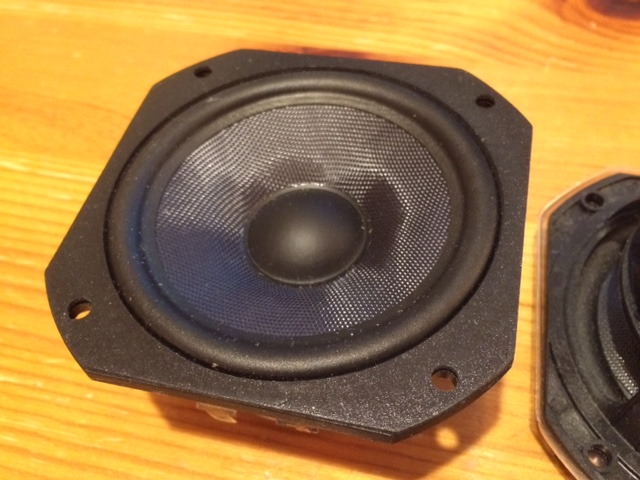
Here is the front and back and a TC9FD on far right for comparison:
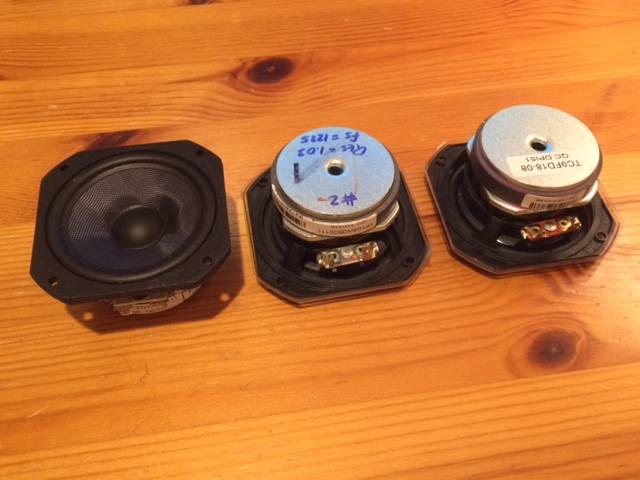
The TS parameters as measured by DATS v2 look reasonable and typical for a TC or TG9 with Qts about 1 and fs about 120Hz and Vas about 1.2 liters, and sensitivity of about 86db at 2.83v. the DC impedance is about 4.5ohms which implies it is more of a 6ohm driver rather than an 8ohm driver.
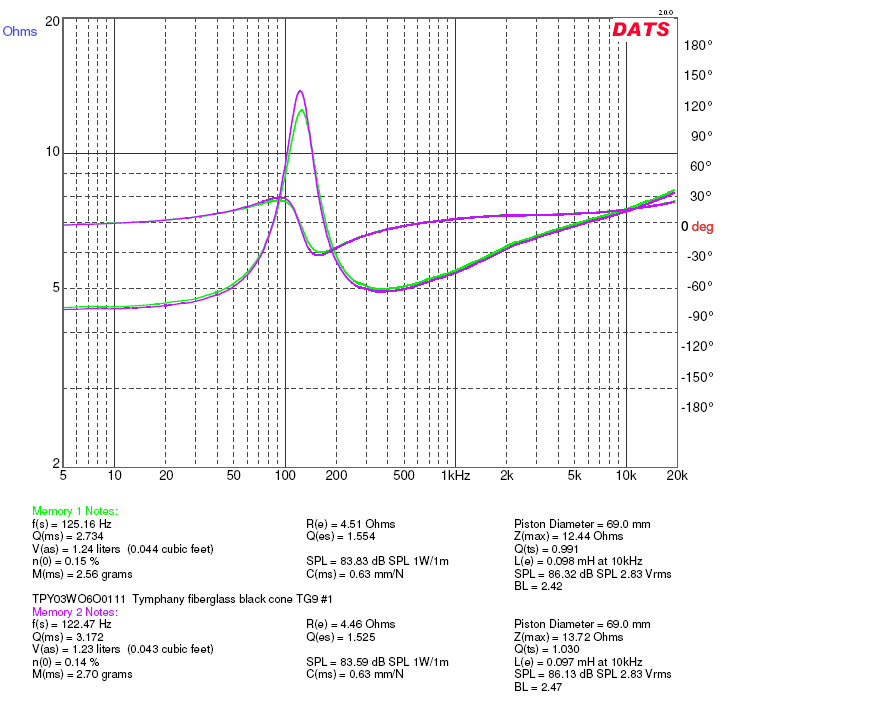
I installed it in my vented aperiodic Dagger TL with a trapezoid baffle (flush rebate mounted) to do some initial measurements. Here is the raw frequency response measured at 0.5m away running full range compared with a TG9FD in the same box (pretty close):
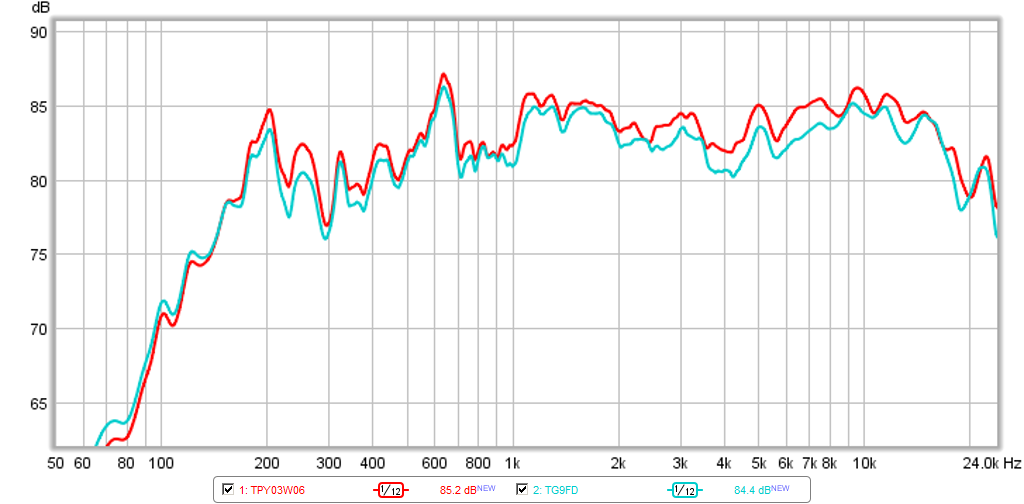
Here is the harmonic distortion stress test where I adjusted drive level to reach 96dB at 0.5m or equivalent 90dB at 1m:

For comparison, here is HD of TG9FD at same drive level:
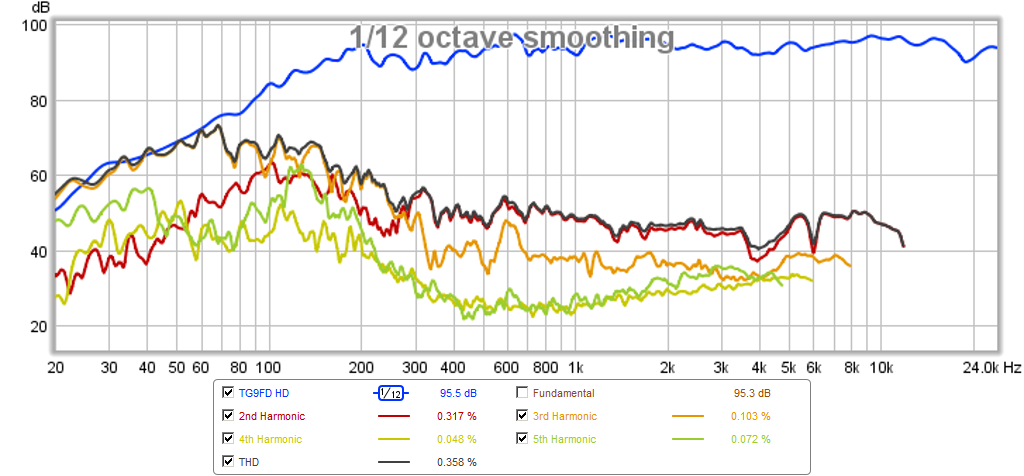
Here is the impulse and step response - quite clean and no ringing:

Here is the HD as measured with a 1kHz excitation in RTA mode at same drive level as above:
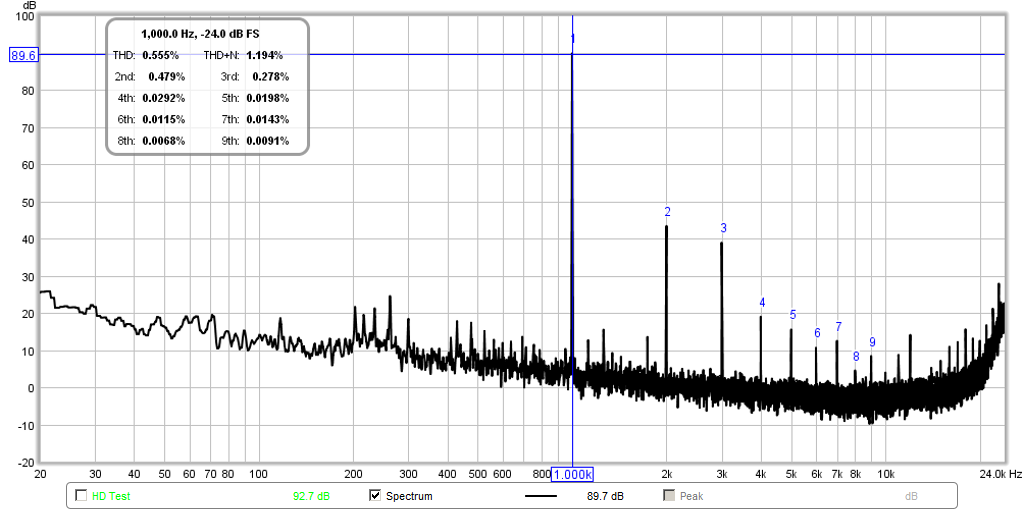
It sounds quite nice - in fact, almost identical to the TG9FD but with a little more harmonic distortion below 300Hz. If you use in a FAST with a >300Hz XO, you probably won't know the difference. Overall, a great sounding driver in my opinion. And I think these can be bought for $5 in India. If you happen to live there, you are in luck. It's a great driver, and a great deal.
And finally here are some sound clips recorded with the UMIK-1 measurement mic at 0.5m and converted to 320kbit mp4. Change .asc extension to .mp3 to listen.
Thank you Rockk19! 🙂

Here is a closeup photo - note the smooth rubbery finish on the bezel. It is a very nice smooth skinned foam rubber gasket that is a lot more attractive than the flimsy gaskets on the TC9FD. Plus it is airtight/watertight if you were to rear mount it to a frame:

Here is the front and back and a TC9FD on far right for comparison:

The TS parameters as measured by DATS v2 look reasonable and typical for a TC or TG9 with Qts about 1 and fs about 120Hz and Vas about 1.2 liters, and sensitivity of about 86db at 2.83v. the DC impedance is about 4.5ohms which implies it is more of a 6ohm driver rather than an 8ohm driver.

I installed it in my vented aperiodic Dagger TL with a trapezoid baffle (flush rebate mounted) to do some initial measurements. Here is the raw frequency response measured at 0.5m away running full range compared with a TG9FD in the same box (pretty close):

Here is the harmonic distortion stress test where I adjusted drive level to reach 96dB at 0.5m or equivalent 90dB at 1m:

For comparison, here is HD of TG9FD at same drive level:

Here is the impulse and step response - quite clean and no ringing:

Here is the HD as measured with a 1kHz excitation in RTA mode at same drive level as above:

It sounds quite nice - in fact, almost identical to the TG9FD but with a little more harmonic distortion below 300Hz. If you use in a FAST with a >300Hz XO, you probably won't know the difference. Overall, a great sounding driver in my opinion. And I think these can be bought for $5 in India. If you happen to live there, you are in luck. It's a great driver, and a great deal.
And finally here are some sound clips recorded with the UMIK-1 measurement mic at 0.5m and converted to 320kbit mp4. Change .asc extension to .mp3 to listen.
Attachments
-
 01-tpy03w06-photo-1.PNG578.3 KB · Views: 1,363
01-tpy03w06-photo-1.PNG578.3 KB · Views: 1,363 -
09-tpy03w06-Clip-1.asc1.7 MB · Views: 116
-
 08-tpy03w06-rta-1khz.png76.9 KB · Views: 1,260
08-tpy03w06-rta-1khz.png76.9 KB · Views: 1,260 -
 07-tpy03w06-ir-sr.png55.4 KB · Views: 1,263
07-tpy03w06-ir-sr.png55.4 KB · Views: 1,263 -
 06-tg9fd-hd.png146.4 KB · Views: 1,285
06-tg9fd-hd.png146.4 KB · Views: 1,285 -
 05-tpy03w06-hd.png152.9 KB · Views: 1,293
05-tpy03w06-hd.png152.9 KB · Views: 1,293 -
 04-tpy03w06-compare-tg9fd.png84.5 KB · Views: 1,303
04-tpy03w06-compare-tg9fd.png84.5 KB · Views: 1,303 -
 03-TPY03W06-TS-params.PNG60.6 KB · Views: 1,290
03-TPY03W06-TS-params.PNG60.6 KB · Views: 1,290 -
 02-tpy03w06-photo-2.PNG556.7 KB · Views: 1,315
02-tpy03w06-photo-2.PNG556.7 KB · Views: 1,315 -
10-tpy03w06-Clip-2.asc1.7 MB · Views: 107
Last edited:
You are welcome X 
Hope to see the TPY03 in your next subjective round.
This driver is astonishingly similar to the TG9 in the frequency response graph. The higher distortion in the lower octaves might be due to its higher resonance frequency (120Hz vs 100Hz approx) compared to the TG9.
This cone is supposed to be Kevlar not glass fiber. A subjective test between the TPY03 and the TG9 can help illustrate differences between kevlar and glassfiber as cone material as otherwise these drivers are very similar.

Hope to see the TPY03 in your next subjective round.
This driver is astonishingly similar to the TG9 in the frequency response graph. The higher distortion in the lower octaves might be due to its higher resonance frequency (120Hz vs 100Hz approx) compared to the TG9.
This cone is supposed to be Kevlar not glass fiber. A subjective test between the TPY03 and the TG9 can help illustrate differences between kevlar and glassfiber as cone material as otherwise these drivers are very similar.
This cone is supposed to be Kevlar not glass fiber. A subjective test between the TPY03 and the TG9 can help illustrate differences between kevlar and glassfiber as cone material as otherwise these drivers are very similar.
Oh, my mistake then. Kevlar (aramid) is intrinsically yellow - so they dyed it or painted it somehow. The cone surface doesn't look painted though.
Regarding another subjective test: it will take some time for more drivers to appear for testing. Of course, I could just record sound clips from this driver in the same setup as Rounds 3-5 and have it there as a reference for anyone wishing to compare to the other drivers.
How much do these sell for in India? It looks like you guys have quite an active diy community in India.
I bought quite a few of these for my arrays from someone who managed to lay his hands on a surplus OEM drivers auction/buyout. I am not sure if he was any left.
These drivers are not available at retail.
For anyone interested, I can pass on the message to the person I bought these from.
Yes, we do have a somewhat active DIY community here in India 🙂
These drivers are not available at retail.
For anyone interested, I can pass on the message to the person I bought these from.
Yes, we do have a somewhat active DIY community here in India 🙂
Here is the comparison with the TG9FD gated 0.5ms before and 5ms after and presented at 1/48th octave averaging, and 2dB/div vertical scale. Remarkably similar. The increased sensitivity is due to the 6ohm rating but about the same if normalized to 1 watt.
I opened up the upper end of the measurement to 24khz and we can see there is an ultrasonic breakup at 22kHz.
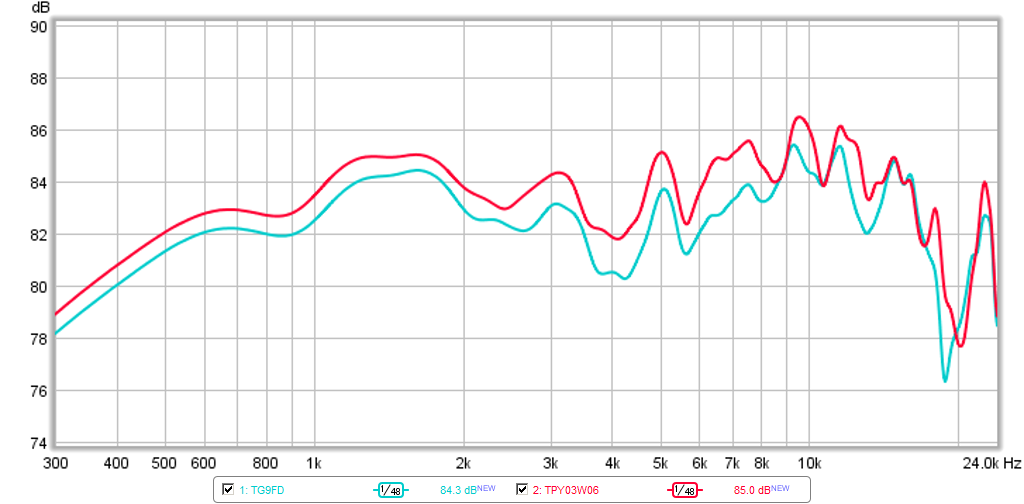
I opened up the upper end of the measurement to 24khz and we can see there is an ultrasonic breakup at 22kHz.

Attachments
Last edited:
Please compare this driver with the TC9 paper cone if you have the opportunity.
From the datasheets, the TC9 seems to have high on-axis cone breakup peaks. In that case, its not possible to equalize the drooping off-axis response as it will make the on-axis peaks only worse. The TPY03 seems to have advantage with a drooping on-axis response thats proportionate with the off-axis droop.
From the datasheets, the TC9 seems to have high on-axis cone breakup peaks. In that case, its not possible to equalize the drooping off-axis response as it will make the on-axis peaks only worse. The TPY03 seems to have advantage with a drooping on-axis response thats proportionate with the off-axis droop.
TC9 off axis measurements:

TG9 off axis measurements:

I'd say both these drivers follow the on axis response when measured at 15 degree very closely. I see no problem to apply EQ off axis within a 15 degree window. Nor did I measure a problem after applying EQ and measuring at different spots in the room. If the TG was that much better I would have ordered those in 2011 😉. I was very close to doing just that. But I'll admit I have a thing for paper cones. It wasn't the price difference that steered me that way.
The TG9 will have a bit more HF at 30 degree off axis after EQ. I expect the TYP03 will act very similar to the TG.
(*) not my measurements. But also confirmed here: https://www.hifi-selbstbau.de/datenbler-mainmenu-40/breitbandchassis-mainmenu-90/259-vifa-tc9fd8
The TYP03 is probably going to look like this one? https://www.hifi-selbstbau.de/datenbler-mainmenu-40/breitbandchassis-mainmenu-90/59-vifa-10-bgs-1206
TG9 off axis measurements:
I'd say both these drivers follow the on axis response when measured at 15 degree very closely. I see no problem to apply EQ off axis within a 15 degree window. Nor did I measure a problem after applying EQ and measuring at different spots in the room. If the TG was that much better I would have ordered those in 2011 😉. I was very close to doing just that. But I'll admit I have a thing for paper cones. It wasn't the price difference that steered me that way.
The TG9 will have a bit more HF at 30 degree off axis after EQ. I expect the TYP03 will act very similar to the TG.
(*) not my measurements. But also confirmed here: https://www.hifi-selbstbau.de/datenbler-mainmenu-40/breitbandchassis-mainmenu-90/259-vifa-tc9fd8
The TYP03 is probably going to look like this one? https://www.hifi-selbstbau.de/datenbler-mainmenu-40/breitbandchassis-mainmenu-90/59-vifa-10-bgs-1206
Attachments
Last edited:
Actually I was referring to the 30 degrees off-axis response comparison between the TC9 and TG9. This is some difference indeed. Thanks for the graphs.
If the Kevlar coned BGS is a predictor of the behaviour than the TYP03 would mimic the TC9 more than the TG9 in the upper ranges at 30 degree off axis. Would be interesting to see if that difference is there between TG and Typ03.
But when would one be equalising the 30 degree off axis response? That happens only when there is no toe-in of the arrays. My toe in is between 15 and 20 degree, making the spot at the mic between 10-15 degree off axis. Outer drivers are more off axis to the microphone and thus more attenuated at higher frequencies (above 10K). At least that's how I looked at it. Pretty ideal if you ask me. That's why 15 degree was more important to me than 30, so it would have sort of natural shading for the outer drivers the higher in frequency one goes.
But when would one be equalising the 30 degree off axis response? That happens only when there is no toe-in of the arrays. My toe in is between 15 and 20 degree, making the spot at the mic between 10-15 degree off axis. Outer drivers are more off axis to the microphone and thus more attenuated at higher frequencies (above 10K). At least that's how I looked at it. Pretty ideal if you ask me. That's why 15 degree was more important to me than 30, so it would have sort of natural shading for the outer drivers the higher in frequency one goes.
30 degrees is important from power response point of view or when playing for a large audience. Otherwise, almost everyone toes in; I listen to my arrays right on axis. A rising on-axis or 15deg response is actually good for an array given the HF attenuation.
The TYP03 has very good 30 degrees response as per my measurements. But then I can't compare it to some graphs of TC9 or TG9 from the internet given the difference in test methods. I can get the TC9 just for measurements sake but it retails for around $24 here.
The TYP03 has very good 30 degrees response as per my measurements. But then I can't compare it to some graphs of TC9 or TG9 from the internet given the difference in test methods. I can get the TC9 just for measurements sake but it retails for around $24 here.
The PC9 off axis response justifies why I'm adding a tweeter... at least to me. Thanks for posting the charts.
One driver or 25 in a row is going to be a bit different 🙂.
Let me clarify that, not in off axis response, but in total sound going into the room.
Let me clarify that, not in off axis response, but in total sound going into the room.
Last edited:
Black TG9 works great with RS225 in FAST
I installed this new driver in my RS225 FAST speaker normally where the ScanSpeak 10F resides. I redid the XO with to match a textbook 4th order LPF and 2nd order HPF by using a BW3 at 325Hz on the woofer and a BW1 at 500Hz on the full range to get a 500Hz acoustic Harsch XO. With minimal EQ, this driver is monitor flat. The sensitivity perfectly matches the RS225 (after baffle step) so no level matching required.
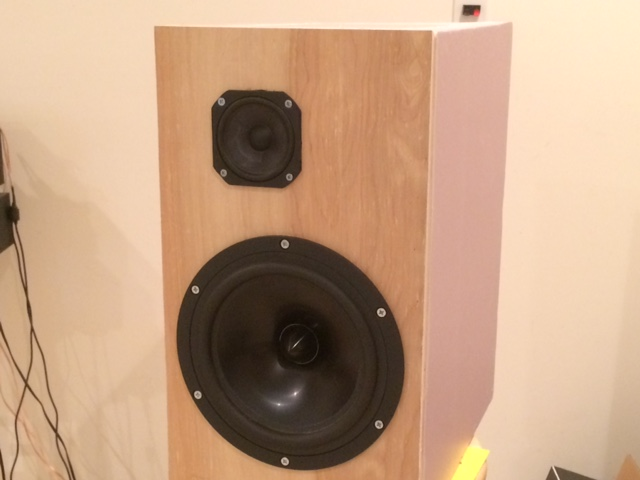
Here are the measurements.
XO (acoustic 500Hz):
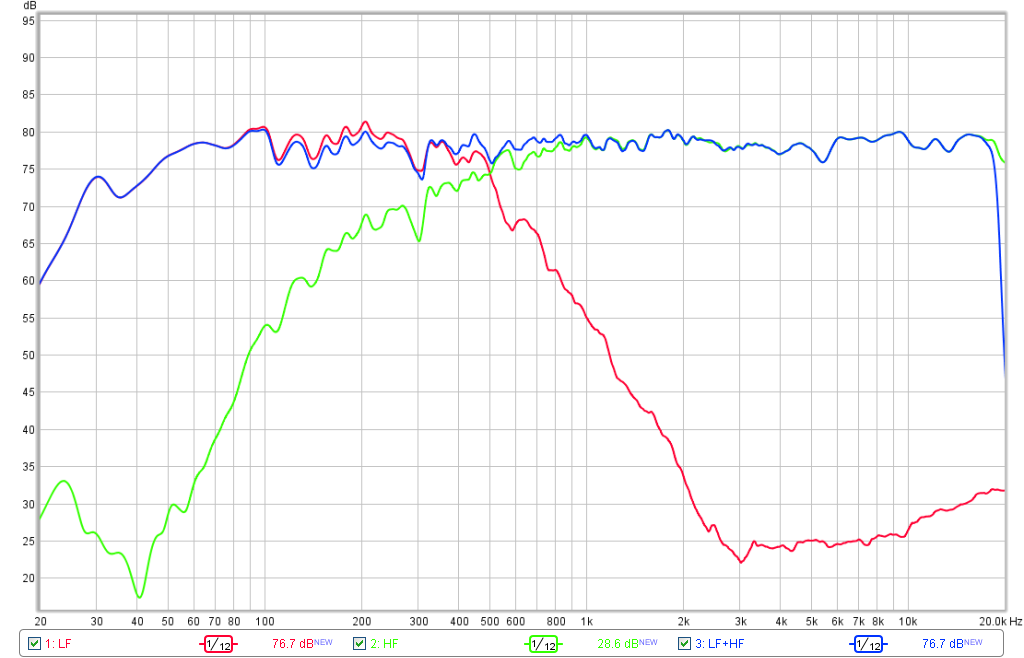
Phase (+/- 30 deg variation over bandwidth):
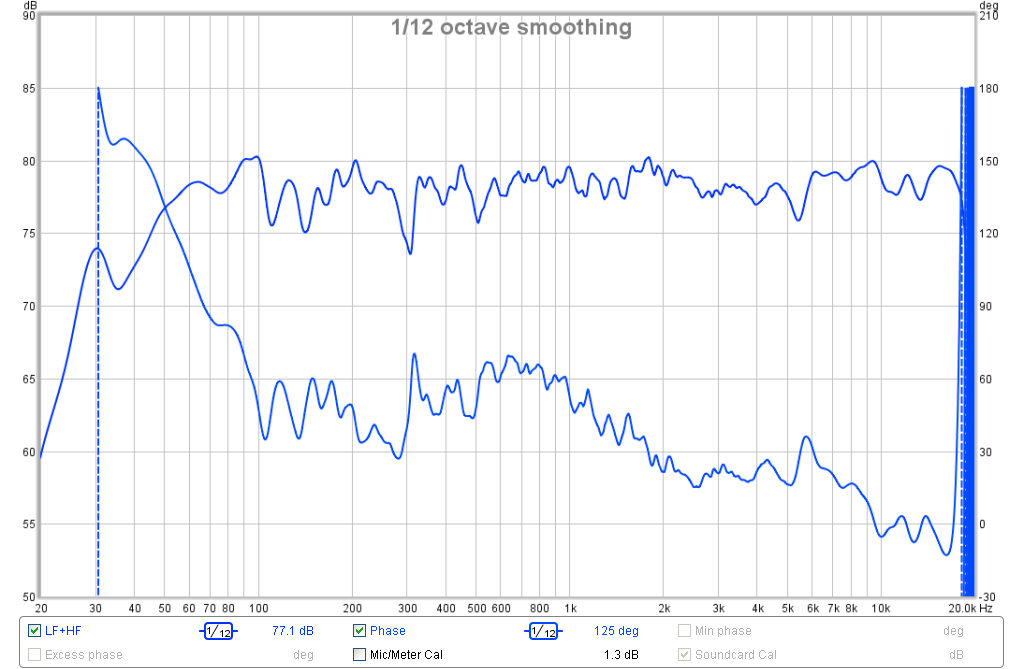
Impulse/Step Response (typical quasi transient perfect Harsch):
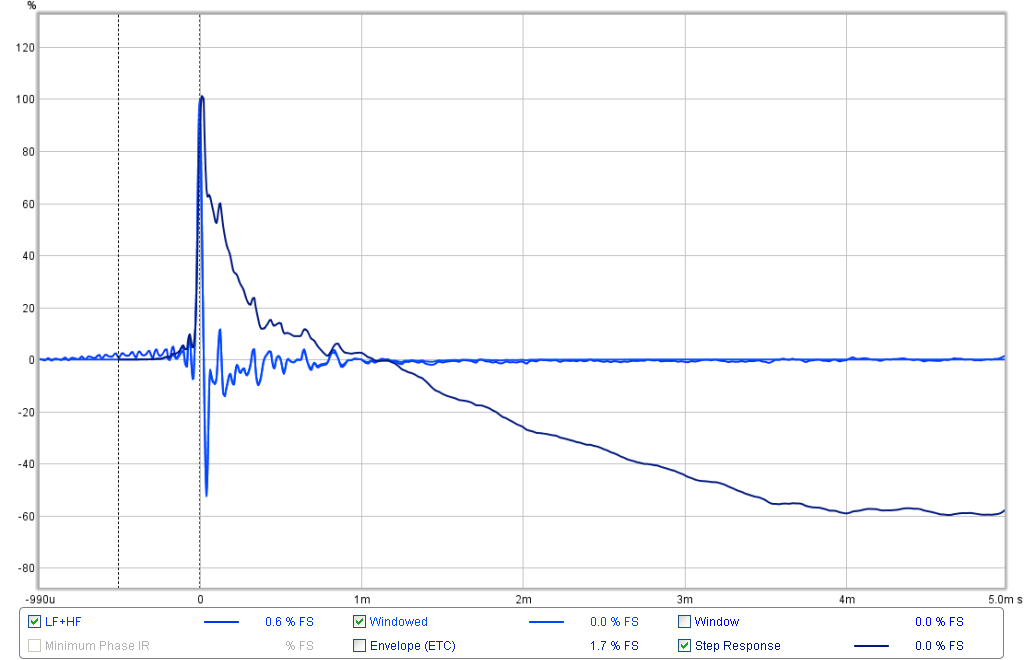
HD (at low volume - I have a buzz/rattle in the cabinet, but fairly clean):
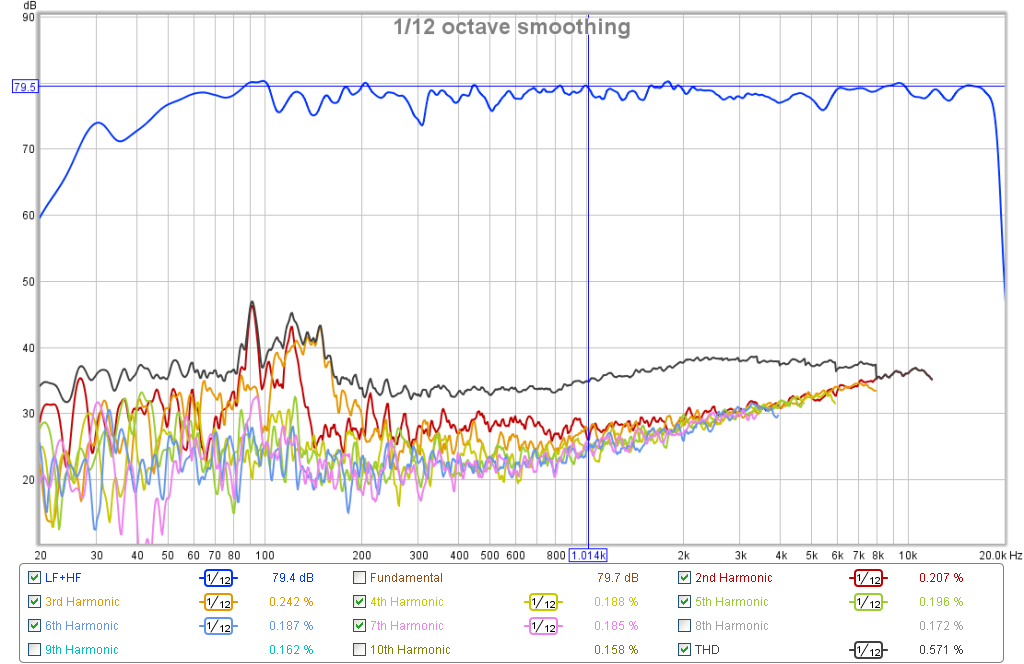
GD (under 6ms at 50Hz):
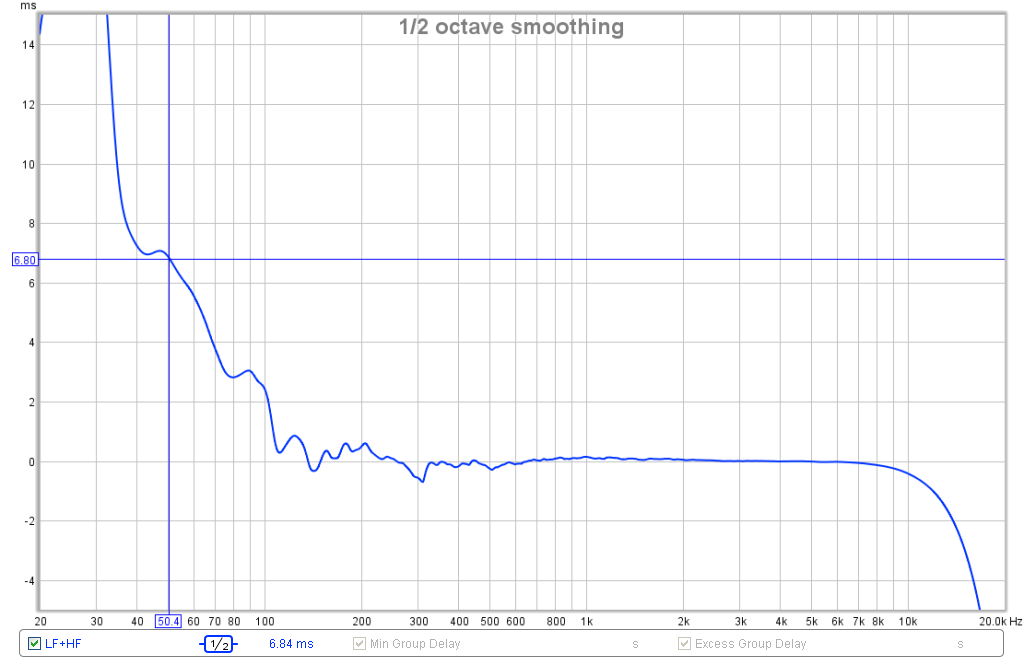
CSD:

Spectrogram:
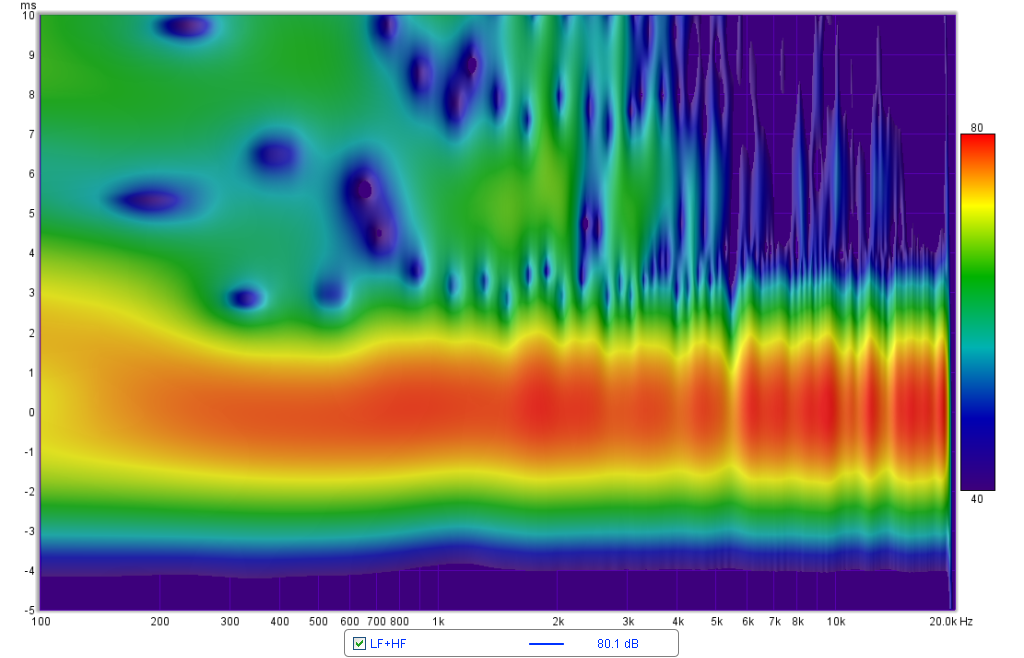
It sounds excellent! If you can get your hands on these, they are a nice full range driver capable of hitting a good 20kHz.
I installed this new driver in my RS225 FAST speaker normally where the ScanSpeak 10F resides. I redid the XO with to match a textbook 4th order LPF and 2nd order HPF by using a BW3 at 325Hz on the woofer and a BW1 at 500Hz on the full range to get a 500Hz acoustic Harsch XO. With minimal EQ, this driver is monitor flat. The sensitivity perfectly matches the RS225 (after baffle step) so no level matching required.

Here are the measurements.
XO (acoustic 500Hz):

Phase (+/- 30 deg variation over bandwidth):

Impulse/Step Response (typical quasi transient perfect Harsch):

HD (at low volume - I have a buzz/rattle in the cabinet, but fairly clean):

GD (under 6ms at 50Hz):

CSD:

Spectrogram:

It sounds excellent! If you can get your hands on these, they are a nice full range driver capable of hitting a good 20kHz.
Attachments
-
 tpy03-rs225-fast-csd.png208.7 KB · Views: 788
tpy03-rs225-fast-csd.png208.7 KB · Views: 788 -
 tpy03-rs225-fast-gd.png45.3 KB · Views: 791
tpy03-rs225-fast-gd.png45.3 KB · Views: 791 -
 tpy03-rs225-fast-hd.png182 KB · Views: 1,059
tpy03-rs225-fast-hd.png182 KB · Views: 1,059 -
 tpy03-rs225-fast-ir-sr.png54.2 KB · Views: 795
tpy03-rs225-fast-ir-sr.png54.2 KB · Views: 795 -
 tpy03-rs225-fast-phase.png90.2 KB · Views: 813
tpy03-rs225-fast-phase.png90.2 KB · Views: 813 -
 tpy03-rs225-fast-xo.png77.3 KB · Views: 803
tpy03-rs225-fast-xo.png77.3 KB · Views: 803 -
 tpy03-rs225-fast-spectrogram.png694.2 KB · Views: 811
tpy03-rs225-fast-spectrogram.png694.2 KB · Views: 811 -
 fast.PNG372.9 KB · Views: 836
fast.PNG372.9 KB · Views: 836
Last edited:
Thank you so much Mr. X for the measurements.
These drivers do sound excellent; even more with 25 pieces per channel 🙂
These drivers do sound excellent; even more with 25 pieces per channel 🙂
Great work and amazing stuff - thanks to xrk971, wesayso and rockk19 for these measurements and all their work on line-arrays, full-ranges, subjective tests and everything else. I missed some of the action on this forum due to the floods in Chennai (India) over the last couple of months, but rockk19 gave me a heads-up on the thread. I had supplied him 50+ drivers for his line array earlier this year and am amazed that he was able to complete it so quickly.
Earlier, I had also promised a few to xrk971 for his measurements and subjective tests, but couldn't ship them to him on time - I'm glad that rockk19 was able to oblige with a pair of his spares.
I still have a small quantity of both the 6-ohm and 12-ohm drivers, and almost all of them survived the December flooding by virtue of being in dry storage upstairs. Just two of them got wet downstairs, and they too seem to have survived after drying out - another virtue of kevlar and plastics over paper cones. I mostly use the 12-ohm drivers in dual-driver TABAQ boxes, where they can handle 60 Wpc rms when paralleled to 6 ohms. The 6-ohm driver I've mainly used for satellites, but xrk's FAST above is a great idea with superb performance from the graphs above. I'll try to steer people to the FAST design if anybody is up to it in the DIY community in India. They may have to go with lesser woofers, but we'll see how it goes.
Edit: As noted earlier, these share a lot of DNA with the ScanSpeak 10F and Vifa TG9/TC9, so in hindsight it's not a surprise that the graphs look very similar. Even the mounting dimensions are probably identical.
Earlier, I had also promised a few to xrk971 for his measurements and subjective tests, but couldn't ship them to him on time - I'm glad that rockk19 was able to oblige with a pair of his spares.
I still have a small quantity of both the 6-ohm and 12-ohm drivers, and almost all of them survived the December flooding by virtue of being in dry storage upstairs. Just two of them got wet downstairs, and they too seem to have survived after drying out - another virtue of kevlar and plastics over paper cones. I mostly use the 12-ohm drivers in dual-driver TABAQ boxes, where they can handle 60 Wpc rms when paralleled to 6 ohms. The 6-ohm driver I've mainly used for satellites, but xrk's FAST above is a great idea with superb performance from the graphs above. I'll try to steer people to the FAST design if anybody is up to it in the DIY community in India. They may have to go with lesser woofers, but we'll see how it goes.
Edit: As noted earlier, these share a lot of DNA with the ScanSpeak 10F and Vifa TG9/TC9, so in hindsight it's not a surprise that the graphs look very similar. Even the mounting dimensions are probably identical.
Last edited:
Good idea with parallel drivers for Tabaq. Did you have to modify the box volume by 2x?
I used the same dimensions as the single-driver TABAQ box. There's probably a small change in effective volume due to the magnet of the upper driver sticking into the resonant channel, plus the volume of the upper cutout minus the cone frustum. The upper driver is placed 10 cm above the lower driver, giving an acoustic center-point for the superposed drivers that's 5 cm above the lower driver. It just happens to coincide with an earlier recommendation by Bjorn that it doesn't hurt to raise the (single) driver by 5 cm from the published diagram for the TABAQ box.
Thanks all involved this thread, cant remember where i seen data these black TC9 clones in past but always thought they would roll off in HF a lot before TC9/TG9/10F, but they certainly do HF just as fine. Measured data when in FAST paired RS225-8 looks very good and point to will sound as good or same or better than more expensive 10F that sat there before 🙂.
For reference, here's the Parts Express page on the Tymphany TPY03w06o0111 6-ohm driver, with T/S parameters and other specs.:
Tymphany TYPY03W06O0111 3-1/2" Full Range Driver
The key T/S parameters were measured independently by a DIYer here in India, and found to be very close to the published specs at the PE link above. Also note the slight misspelling on the part name (TYPY... vs. TPY...), which may have made it difficult to find the page through search engines. PE hasn't had it in stock for a while, so the page probably hasn't been corrected/updated for some years.
The specs of the 12-ohm version are still elusive on the web.
Tymphany TYPY03W06O0111 3-1/2" Full Range Driver
The key T/S parameters were measured independently by a DIYer here in India, and found to be very close to the published specs at the PE link above. Also note the slight misspelling on the part name (TYPY... vs. TPY...), which may have made it difficult to find the page through search engines. PE hasn't had it in stock for a while, so the page probably hasn't been corrected/updated for some years.
The specs of the 12-ohm version are still elusive on the web.
- Status
- Not open for further replies.
- Home
- Loudspeakers
- Full Range
- TPY03W06O0111 (a.k.a. OEM Black TG9FD)


